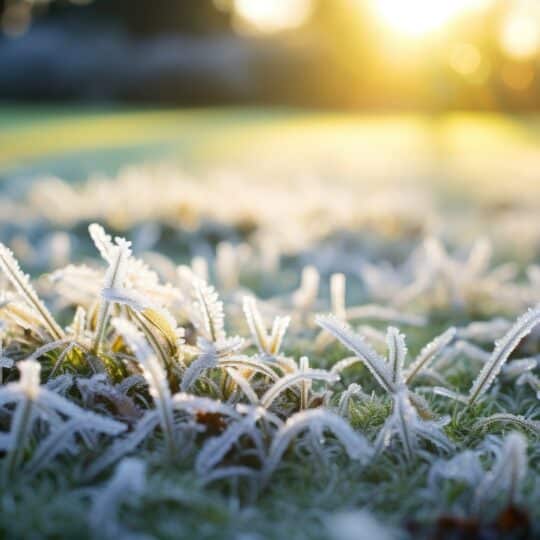4 Ways Winter Can Damage Your Lawn
And How to Help Protect It

Between the freezing temperatures and icy weather, winter can take a toll on many living things. While we can shield ourselves with warm clothing and retreat indoors, your lawn doesn’t have this luxury. Learn about the different types of winter lawn damage and how you can help protect your grass this season.
Winter Lawn Damage
During the winter, grass goes through a dormant period where it stops growing to conserve energy. You may notice patches of brown across your lawn, but this doesn’t mean it’s dead. Cool-season lawns are more likely to survive the frigid season, but there are still certain conditions that could cause damage.
- Traffic. Your grass is thinner and more brittle in the winter time, especially when covered in frost. Walking across the lawn can break the blades and form plodded paths that don’t bounce back. Try to keep off the grass, at least until the frost has melted. This goes for your pets as well. Instead, keep sidewalks clear of snow and ice to avoid cutting through the grass. Definitely don’t park anywhere on your lawn. These impressions not only kill the grass but can also compact the soil.
- Desiccation. Winter’s cold, dry winds can suck the moisture right out of your lawn and plants. You can help prevent dehydrated grass and shrubs by maintaining a regular watering schedule throughout the fall. Add a layer of mulch around your well-watered shrubs to help retain moisture during the drier seasons.
- Snow Mold. When snow covers the ground for an extended period of time, it not only weighs down on the lawn but it also traps moisture, creating the ideal conditions for mold. You may not notice the effects until spring when matted, discolored patches of grass appear. But you can help prevent snow mold in the late fall by keeping your grass short. Longer blades are more likely to become matted down. You can also help prevent large piles of snow by not mounding shoveled snow into your lawn.
- Crown Hydration. Your lawn goes through repeated cycles of freezing and thawing in the winter. When it thaws, frost melts and the plants absorb the water. However, when the temperatures drop, the absorbed water re-freezes. This can rupture plant cell membranes and damage the grass. Large patches of discolored turf is more common in poorly drained areas. You can help prevent this by properly aerating the soil to break up any soil compaction.
Preventing Winter Lawn Damage
The key to protecting your lawn in winter is to properly maintain it during every other season, especially in the fall. A lawn that’s well-watered, mowed, and fertilized is more likely to survive the harsh winter conditions and bounce back beautifully in the spring. If you do find yourself with thin, dead patches of grass when it should be coming back to life, there are ways to repair your lawn.
Contact Green Image Lawn Care to help restore your grass to its lush, green glory. We’ll also help you devise a plan to maintain the health of your lawn throughout the year so it’s better equipped to survive the harsher seasons.